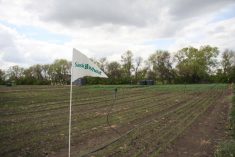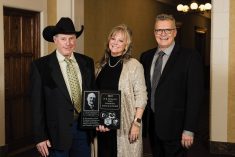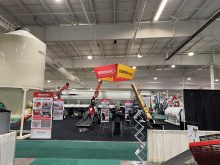Coming out of the packed train station, our friend Markus points across the street to where a large group is gathered. “Those are all farmers over there,” he says. “That’s got to be the right tram.” What is it about farmers that makes them stand out in a city? Clothing? Posture? Haircuts? Markus was right, about the farmers and the tram.
There’s very little parking for pickups or other vehicles at AGRAMA, the Swiss Agriculture and Forestry Machinery and Technology show, held in the capital city of Bern. Land is at a premium in this small country and public transport is readily available. We’re a little early, but already there is a lineup at the entrance gate, even though it’s Monday, the last day of the show. It’s raining lightly, there’s a tight covering of umbrellas over mostly bare heads. I’m grateful for online ticket sales — we’re in quickly.
I’ve gone to farm shows in Canada, Africa, Germany and Switzerland. There are notable differences. Canadian farmers wear ball caps. In Zambia, women are more likely than men to be found in discussions with the salesmen selling small-farm technology. In Germany, beer is an important part of the show. In Switzerland, dealerships offer their customers a glass of wine. Other things are universal. It doesn’t matter which country the show is in — big shiny machinery seems to attract men and boys more than women.

That’s where my husband Robert and Markus are headed. I have an interview scheduled with a farm woman from the Netherlands I’d met in the summer. She’s helping out at the booth managed by her Swiss friends. Willemien’s summary after three days at AGRAMA: “AGRAMA is a miniature of Agritechnica, the World Agriculture show in Hanover.” She finds the Swiss very nice and polite, but hard to get to know on a deeper level. “When you do, they’re wonderful people.”
Buying at the show
On my own tour of the machinery dealers, I heard a comment from all of them which surprised me somewhat. Agriculture and forestry machinery dealer Thomas Rindisbacher told me that farmers often don’t do their homework when purchasing a new piece of machinery. They haven’t asked themselves the questions: What does the machine need to do for me? How long do I want it to last? Could a custom outfit do the job? “They come to AGRAMA, go from one machinery dealer to the other, and whoever makes them the best offer, they take it.”
Read Also

Cancer agency reclassifies another herbicide ‘probably carcinogenic’
The WHO’s cancer research agency has now put atrazine, a herbicide well known to corn growers, in the same potential-hazard category where the agency put glyphosate.
Rindisbacher has a neighbour who owns five or more tractors. Only one of them is compatible with the front-end loader, which he needs every day. That tractor is often on the go with other things. “He doesn’t really think things through.”
The Kubota salesman thinks that Canadian farmers are more likely to make decisions based on logical business factors than the Swiss farmers are; more likely to ask themselves, “What do I need the machine for and what does it have to do?” I wonder, if I would go around to the machinery dealers at the Red Deer or Regina shows, if they would agree. Are Canadian farmers that different?
It is true that most Swiss farmers are more emotionally attached to their farm than the average Canadian farmer might be. The farm has usually been in the family for generations. The public, too, has a strong sense of attachment to family farms, something the farm lobby is capitalizing on. People are still mostly willing to shoulder the taxes the heavily subsidized industry requires, and pay higher prices for food produced in Switzerland. Farming has not traditionally been seen as a business so much as an honourable profession. Things are changing though. Increasingly agriculture is coming under a critical public eye. Young farmers are realizing that they have to approach the farm as a business or they’ll go under.
Over in the John Deere tent, the salespeople were busy. I finally got the eye of Reto Bühler. Behind him stood a new line of John Deere tractors, dominated by the 6155R. Reto told me the first number (6) is the series. The next two or three (155) are the Horsepower. The third (R) is the model. The R is the most fully loaded model on the Swiss market. “It probably doesn’t make financial sense to purchase an R tractor unless you operate more than 20 hectares,” Bühler says. Only the R model has the variable shift option though. “The Swiss farmer would rather buy the best he can afford, than what will do the job most efficiently for the least dollars.” When I told him that I’d just heard those words from the Kubota salesman he quickly interjected: “There are worlds between a John Deere and a Kubota! You can’t compare the two.”

I spent some time discussing John Deere’s new Expert Alert technology with Christoph Henni. (If you haven’t heard of the technology and have newer equipment, it’s worth checking out.) Before I left, he said, “Swiss farmers tend to purchase the fully loaded machine, even if they don’t need it.”
The conclusions of the machinery dealers surprised me a bit. This doesn’t really fit in with the general tone I hear among farmers that it’s getting increasingly difficult to manage a decent living from the farm. But it does fit in with my experience. My farmer man and I had our own disagreements over machinery purchases. I couldn’t see why he needed a GSP system for steering. He bought it anyway. I softened when came home much more relaxed from a day in the field. The next disagreement was over a new combine with all the bells and whistles. Why would you pay that much? Because he wanted it and could afford it. Was that because he’s Swiss? I’m not so sure. Next time I visit an agriculture show in another country, I’m going to go by the machinery dealers and find out!















